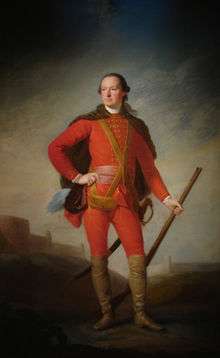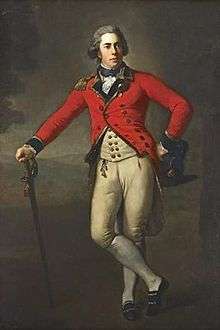Martha Bruce, Countess of Elgin and Kincardine
Martha Bruce, Countess of Elgin and Kincardine (1739 – 21 June 1810), born Martha White and known for most of her life as Lady Elgin, was the wife of Charles Bruce, 5th Earl of Elgin and 9th Earl of Kincardine, mother of the collector Thomas Bruce, 7th Earl of Elgin, and governess to Princess Charlotte of Wales, daughter of the future King George IV, at the time second in line to the throne.



Marriage and children
The only child of Thomas White, or Whyte, a banker of Kirkaldy and London, Martha White married Charles Bruce, who was already Earl of Elgin and Kincardine, at Edinburgh on 1 June 1759.[1] Their eight children were Thomas Bruce, 7th Earl of Elgin (1766–1841), known for the removal of the Elgin Marbles from the Parthenon in Athens;[2] Lady Martha Bruce (1760–1767); Lady Janet Bruce (1761–1767); William Bruce, Lord Bruce (15 January 1763 – 27 March 1763); William Bruce, 6th Earl of Elgin (1764–1771); Charles Andrew Bruce (1768–1810), briefly a Governor of Prince of Wales's Island; James Bruce (1769–1798), briefly a Member of Parliament; and Lady Charlotte Bruce (28 May 1771 – March 1816), who married Captain (later Admiral) Philip Charles Durham.[3][4]
In 1762, Lady Elgin's portrait was painted by the fashionable Allan Ramsay, who the same year painted King George III.[5]
Lady Elgin's eldest son, William Robert, born in 1763, lived only ten weeks. Her two eldest daughters, Martha and Janet, died in 1767 at the ages of seven and six. On 14 May 1771, she was widowed, and only two months later her second son, also called William Robert, the new Lord Elgin, died at the age of seven. Her remaining four children, three sons and a daughter, all lived to adulthood, but on 10 July 1798 her youngest surviving son, James, then aged twenty-nine, was drowned while crossing the River Don at Barnby Dun in Yorkshire when his horse was swept away by the stream.[3][6]
Later life
In 1799,[7] on the instructions of King George III, and with the title of "Gouvernante", Lady Elgin was appointed to superintend Princess Charlotte of Wales,[1][8] only child of the Prince of Wales and already seen as the probable next heir to the throne, with whom she became very close. They lived together in a household otherwise consisting entirely of servants[9] at Warwick House in the St James's district of Westminster, described as "a rather gloomy edifice near Carlton House".[10] However, during 1804, Charlotte's father insisted on Lady Elgin retiring, ostensibly because she had become too old, but probably because the Prince was angry that Charlotte had been taken to visit her grandfather King George without his permission.[9]
According to Burke's Peerage,
The Countess of Elgin filled, with great credit to herself, the important station of governess to her royal highness the deeply-deplored [sic] Princess Charlotte of Wales.[11]
An obituary of Princess Charlotte in 1818 described Elgin as "a very worthy and pious Countess who acted for some years as Gouvernante".[8] This title has sometimes been translated as "guardian" rather than "governess".[12] Elgin's own obituary in The Gentleman's Magazine said of her, "At Twickenham, in her 69th year, the Right hon. Martha Bruce, Countess of Elgin and Kincardine; whose life has been spent in the uniform exercise of piety and benevolence. Her public and private charities were unbounded."[13] However, The Complete Peerage says she died in her 71st year. She was buried at St Mary's, Twickenham.[1]
Descendants
Elgin's grandchildren included James Bruce, 8th Earl of Elgin (1811–1863), successively Governor of Jamaica, Governor General of British North America, and Viceroy of India; Sir Frederick Wright-Bruce (1814–1867), British Ambassador to China and to the United States; and the barrister and Conservative politician Thomas Charles Bruce (1825–1890). Among her great-grandchildren was Victor Bruce, 9th Earl of Elgin (1849–1917), another Viceroy of India. The present-day 11th Earl of Elgin (born 1924) is her great-great-great-grandson.[3]
Notes
- George Cokayne, The Complete Peerage, vol. E to G (St Catherine Press, Limited, 1926), p. 43: "CHARLES (BRUCE) EARL OF ELGIN... He m., 1 June 1759, at Edinburgh, Martha, only child of Thomas White, of London, Banker... His widow, who was Governess to the Princess Charlotte of Wales, d. at Twickenham, Midx., 21 June, and was bur. there 4 July 1810, in her 71st year."
- "Thomas Bruce, 7th earl of Elgin" in Encyclopædia Britannica, online edition 2008
- Elgin, 1633 Archived 2012-10-12 at the Wayback Machine at cracroftspeerage.co.uk (Cracroft's Peerage online), accessed 20 October 2012
- Martha Whyte at thepeerage.com
- Allan Ramsay, 1713-1784: his masters and rivals. National Gallery of Scotland, 9 August-15 September 1963 (exhibition catalogue, National Gallery of Scotland, 1963), p. 43
- John Debrett, The Peerage of the United Kingdom of Great Britain & Ireland - Volume 2 (1816), p. 709
- Sylvanus Urban, ed., The Gentleman's Magazine, vol. 86 (1799), p. 990
- The Annual Biography and Obituary for the year 1818 (Longman, Hurst, Rees, 1818), p. 239: "At a proper age, the Princess Charlotte was removed from the nursery, and placed, by her Royal Grandfather, under the superintendance of a very worthy and pious Countess who acted for some years as Gouvernante".
- James Chambers, Charlotte and Leopold (London: Old Street Publishing, 2007, ISBN 978-1-905847-23-5) p. 17
- Mary Beacock Fryer & Arthur Bousfield, Lives of the Princesses of Wales (1983, ISBN 0919670695), p. 50: "Princess Charlotte... received her own household at Warwick House, a rather gloomy edifice near Carlton House, where her governess was Martha, Countess of Elgin."
- John Burke, A General and Heraldic Dictionary of the Peerage and Baronetage of the British Empire, Volume 1 (1833), p. 433
- R. A. Melikan, John Scott, Lord Eldon 1751-1838: The Duty of Loyalty (1999, ISBN 0521623952), p. 184
- The Gentleman's Magazine, vol. 80 (1810), part 1, p. 674